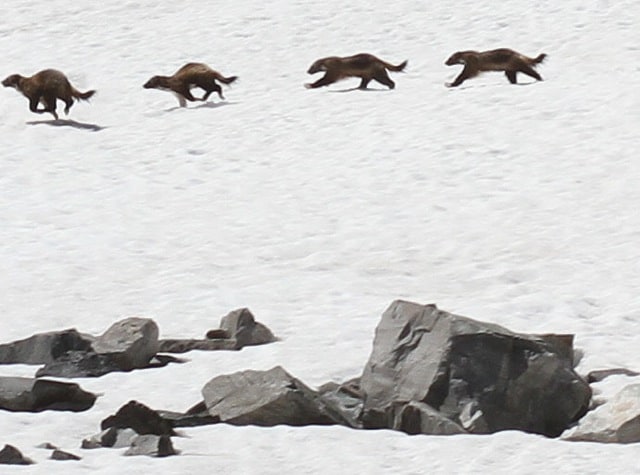The following is a guest post from George Wuerthner. 
Dead. Death. These are words that we don’t often use to describe anything positive. We hear phases like the walking dead. Death warmed over. Nothing is certain but death and taxes. The Grateful Dead. These are words that do not engender smiles, except among Grateful Dead fans. We bring these pejorative perspectives to our thinking about forests. In particular, some tend to view dead trees as a missed opportunity to make lumber. But this really represents an economic value, not a biological value.
From an ecological perspective dead trees are the biological capital critical to the long-term health of the forest ecosystem. It may seem counter-intuitive, but in many ways the health of a forest is measured more by its dead trees than live ones. Dead trees are a necessary component of present forests and an investment in the future forest.
I had a good lesson in the value of dead trees last summer while hiking in Yellowstone. I was walking along a trail that passes through a forest dominated by even-aged lodgepole pine. Judging by the size of the trees, I would estimate the forest stand had its start in a stand-replacement blaze, perhaps 60-70 years before. Strewn along the forest floor were numerous large logs that had fallen since the last fire. Fallen logs are an important home for forest-dwelling ants. Pull apart any of those old pulpy rotted logs and you would find them loaded with ants. Nearly every log I pass along the trail had been clawed apart by a grizzly feasting on ants. It may be difficult to believe that something as small as ants could feed an animal as large as a grizzly. Yet one study in British Columbia found that ants were a major part of the grizzly’s diet in summer, especially in years when berry crop fails.
Who could have foreseen immediately after the forest had burned 60 years before that the dead trees created by the wildfire would someday be feeding grizzly bears? But dead trees are a biological legacy passed on to the next generation of forest dwellers including future generations of ants and grizzly bears.
Dead trees have many other important roles to play in the forest ecosystem. It is obvious to many people that woodpeckers depend on dead trees for food and shelter. In fact, black-backed woodpeckers absolutely require forests that have burned. Yet woodpeckers are just the tip of the iceberg so to speak. In total 45% of all bird species depend on dead trees for some important part of their life cycle. Whether it’s the wood duck that nests in a tree cavity; the eagle that constructs a nest in a broken top snag; or the nuthatch that forages for insects on the bark, dead trees and birds go together like peanut butter and jelly. Birds aren’t the only animals that depend on dead trees. Many bats roost in the flaky bark of old dead snags and/or in cavities.
When a dead tree falls to the ground, the trunk is important habitat for many mammal species. For instance, one study in Wyoming found that without big dead trees, you don’t have marten. Why? Marten are thin animals and as a consequence lose a lot of heat to the environment, especially when it’s cold. They can’t survive extended periods with temperatures below freezing without some shelter. In frigid weather, marten dig out burrows in the pulpy interiors of large fallen trees to provide thermal protection. They may only need such trees once a winter, but if there are no dead fallen trees in its territory, there may not be any marten.
Many amphibians depend on dead trees. Several studies have documented the close association between abundance of dead fallen logs and salamanders. Eliminate dead trees by logging and you eliminate salamanders. Even fish depend on dead trees. As any fisherman can tell you, a log sticking out into the water is a sure place to find a trout lying in wait to grab insects. If you talk to fish biologists they will tell you there is no amount of fallen woody debris or logs in a stream that is too much. The more logs, the more fish.
Even lichens and fungi are dependent on dead trees. Some 40% of all lichen species in the Pacific Northwest are dependent on dead trees and many are dead tree obligates, meaning they don’t grow anyplace else.
Dead trees fill other physical roles as well. As long as they are standing, they create “snow fences” that slows wind-driven snow. The snow that is trapped, melts in place, and helps to saturate the ground providing additional moisture to regrowing trees. Dead trees that fall into streams stabilize and armor the bank, slowing water, and reducing erosion. Dead trees create hiding cover and thermal cover for big game as well.
I was once on a tour with a Forest Service District Ranger who wanted to conduct a post fire logging operation. We were standing near the open barren landscape of a recent clearcut that was adjacent to the newly burnt forest. I pointed out to him that the black snags still had value. He couldn’t see anything but snags waiting to be turned into lumber. I said the snags were still valuable for big game hiding cover. He dismissed my idea out of hand. So I challenged him. I said I have a rifle and you have two minutes to get away from me. Where are you going to run? He didn’t have to ponder the point very long.
Even more counter-intuitive is that dead trees may reduce fire hazard. Once the small twigs and needles fall off in winter storms their flammability is greatly reduced. By contrast, green trees, due to the flammable resins contained in their needles and bark, are actually more likely to burn than snags under conditions of extreme drought, high winds and low humidity. Under such extreme fire-weather conditions, I have seen trees like subalpine fir explode into flame as if they contained gasoline. Fine fuels are what drive fires, not large tree trunks. Anyone who has fiddled around trying to get campfire going knows you gather small twigs, and fine fuels. You don’t try light a twenty inch log on fire.
Dead trees are the biological capital for the forest. Just as floods rejuvenate the river floodplain’s plant communities with periodic deposits of sediment, episodic events like major beetle kill and wildfire are the only way a forest can recruit the massive amounts of dead wood required for a healthy forest ecosystem. Such infrequent, but periodic events may provide the bulk of a forest’s dead wood for a hundred years or more.
All of the above benefits of dead trees are reduced or eliminated by our common forest management practices. Sanitizing a forest by “thinning” to promote so-called “forest health”, post-fire logging of burnt trees , or removal of beetle-killed tree bankrupts the forest ecosystem. And even our mostly ineffective efforts to suppress wildfires and/or feeble attempts to halt beetle-kill reduce the future production of dead wood and leads to biological impoverishment of the forest ecosystem. Creation and recruitment of dead trees is not a loss, rather it is an investment in future forests.
If you love birds, you have to love dead trees. If you love fishing, you have to love dead trees. If you want grizzlies to persist for another hundred years, you have to love dead trees.
More importantly you have to love or at least tolerate the ecological processes like beetle-kill or wildfire. These are the major factors that contribute dead trees to the forest.
So when you see fire-blackened trees or the red needles associated with a beetle kill, try to view these events in a different light-praise the dead: the forests, the wildlife, the fish– all will be pleased by your change of heart.





